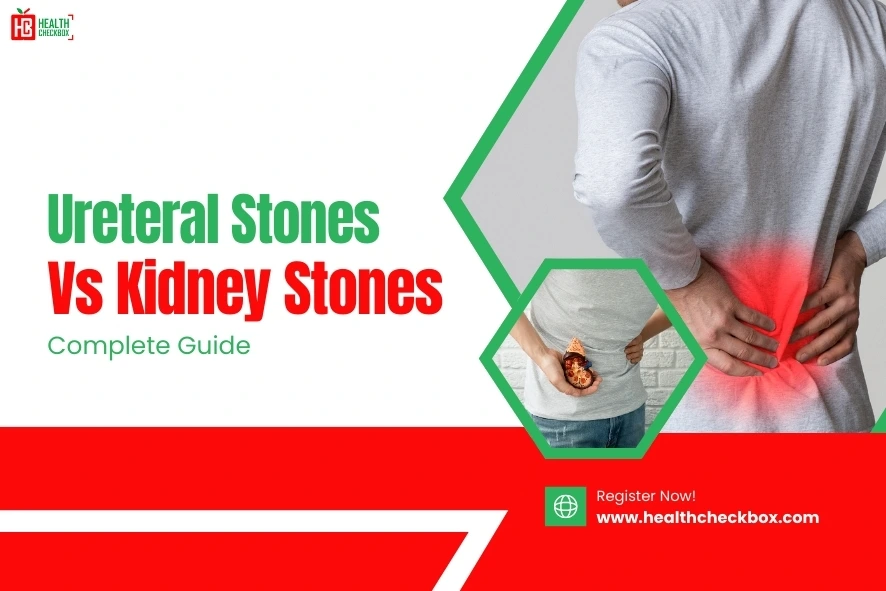If you have ever faced a situation in which your side abdomen or lower back starts to pain, you might think there could be kidney stones or ureteral stones. Although both of these terms are similar, they are different. Both are stones related to the urinary system, but their location of occurrence are different. To identify the symptoms and treatment options, we have to understand the difference between ureteral stones vs kidney stones; key differences, diagnosis, and prevention.
Understand Kidney Stones & Ureteral Stones
There are very slight differences between them as below:
Kidney Stones
When minerals and salt accumulate in your kidneys and form a solid shape, it’s known as a kidney stone. When urine carries an excess amount of substances (uric acid, calcium, and oxalate) that form crystals, it is the cause of the formation of kidney stones.
These stones can be the size of a grain to a small ball. But most of the stones are much smaller than these. When a stone forms and remains in the kidney is known as a kidney stone or renal stone. Most of us don’t know that we have a kidney stone until the stone starts moving and starts hurting.
Ureteral Stones
When a kidney stone moves further and enters the ureter, it will be known as a ureteral stone from that point onwards. Ureters are tubes with a thin membrane that carry the urine from the kidney to the bladder, and when a stone travels into this and remains, it is known as a ureteral stone.
It is the same stone; when it quietly remains in the kidney is referred to as a kidney stone, but when it starts moving, it goes to the ureteral passages, and it is termed a ureteral stone. Just the different location of the stone creates two different terms.
Difference Between Kidney Stones and Ureteral Stones
The difference lies in various aspects as below:
Location
- A kidney stone remains in the kidney only.
- Whereas, when a stone goes to the ureter, the tube connecting the bladder to the kidney, it is a ureteral stone.
- When the same stone moved from the kidney to the ureter, the treatment, medications, and many things changed as well.
Symptoms
- When a stone is settled in the kidney, it typically shows no symptoms.
- An individual only faces pain when the stone starts to move.
- A ureteral stone is more painful and shows major symptoms because it causes a blockage in urine flow.
Pain Location
- It pains in the lower back and side below the ribs if one is suffering from a kidney stone.
- On the other hand, the pain of a ureteral stone is sharp, which moves from the back to the groin.
- The location of the paint often shows the position of the stone in the ureter.
Urgency of Treatment
- If the kidney stone is small and doesn’t cause any problem, it could be examined without the requirement of any immediate action.
- But the ureteral stone requires immediate action because it blocks the complete urine flow in most cases.
Symptoms of Ureteral Stones and Kidney Stones
Between the ureteral stone and vs kidney stone, both show almost the same symptoms. Just the intensity and location can be different:
- A foul smell in urine could be a sign of an internal infection.
- Vomiting and nausea come with severe pain.
- Extreme and sudden pain in the groin area, lower back, and lower abdomen.
- There could be a need to urinate frequently. And a feeling of not emptying the bladder.
- Chills and fever, if they develop inside the body.
- Indication of blood in urine, brown, red, or pink urine.
- A burning sensation or sharp pain during urination.
A pain that comes in a wave is the most accurate and traditional sign of a stone moving in the ureter. The pain waves from your back down to your groin are, and it keeps repeating. This pain could be so painful that many people make it to the emergency wards.
Diagnosis Options to Determine the Stone
In both cases, ureteral stones vs kidney stones, doctors use almost similar methods of diagnosis:
- A CT Scan is the easiest and most accurate method of detecting the stone with its exact position and size.
- For pregnant women, an ultrasound is the best option because of its radiation-free nature.
- Most of the stones can be detected by X-rays, but the smaller stones may be missed by them.
- A test of urine to detect the presence of infectious blood in it.
- A normal blood test to determine the normal functioning of the kidneys and mineral levels.
Treatment Options for Kidney Stones and Ureteral Stones
The treatment options for the stones are categorised into two parts; however the the treatment directly depends on the location, size, and symptoms of the stone.
Conservative Management
- Intake of plenty of water helps in flushing out the small stones as well as toxins in the body.
- Several medicines are used to control the unbearable pain.
- This method is only suitable for the small stones, around 4 to 5 mm.
Medical Procedures
- Using the sound waves to break down the stone into smaller pieces, the process is known as shock wave lithotripsy.
- If the stone is very large, the percutaneous nephrolithotomy method is used to treat it.
- Inserting a thin scope via the urethra and bladder to remove the broken pieces of stone, the process is known as ureteroscopy.
- Placing the stent might be necessary to keep the mouth of the ureter open while the stone passes out of it completely.
How to Prevent Ureteral and Kidney Stones?
Preventive measures for both of them are very similar as below:
- Drinking a minimum of 10-14 glasses of water per day.
- Avoid having oxalate-rich food substances.
- Avoid protein that comes from animals and excess salt or sodium intake.
- Keeping a healthy weight, according to your type of stone.
Conclusion
Between ureteral stones vs kidney stones, it is not that hard to find which one a person is suffering from. Just a few tests or an ultrasound are enough to determine the exact location and position of the stone. Knowing the basic formation of both symptoms and treatments will help you to understand things better and also help you to communicate better with your healthcare provider.
Always remember, a kidney stone becomes a ureteral stone when it starts moving and goes to the ureter. Prevention is always better than critical treatments. Stay hydrated & don’t hesitate to contact your healthcare assistant.

